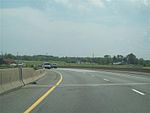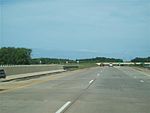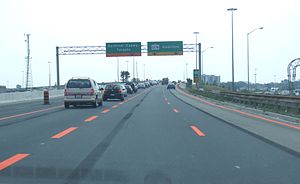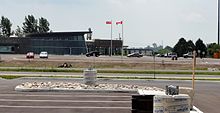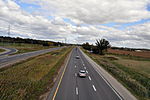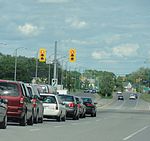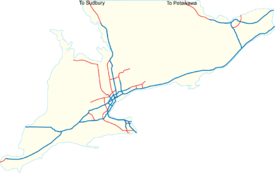- 400-series highways
-
"400-series highways" redirects here. For other uses, see 400-series highways (disambiguation).
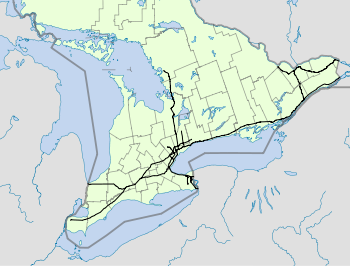 The current 400-series Highway network in Southern Ontario.
The current 400-series Highway network in Southern Ontario.
The 400-series highways are a network of controlled-access freeways throughout the southern portion of the province of Ontario, Canada, forming a special subset of the provincial highway system. They function similarly to the Interstate Highway network in the United States. Modern 400-series highways have high design standards, speed limits of 100 kilometres per hour (62 mph), and various collision avoidance and traffic management systems. 400-series highway design has set the precedent for a number of innovations used throughout North America, including the parclo interchange.
The province's baseline standard for the construction of a 400-series highway (or any controlled-access freeway in Ontario) is an average traffic count of 10,000 vehicles per day. However, other factors are considered as well. To promote economic development in a disadvantaged region (e.g. current construction extending Highway 400 to Northern Ontario), a 400-series highway may be built where the existing highway's traffic counts fall below 10,000. As well, for environmental, budgetary or community reasons, some proposed 400-series highways (e.g. the Highway 400 extension from the 401 to the Gardiner Expressway cancelled in the 1960s) have not been built, even where an existing highway's traffic counts exceed the standard.
Contents
Network
 Heavy traffic on Highway 401 in Toronto, the longest, widest and busiest 400-Series highway.
Heavy traffic on Highway 401 in Toronto, the longest, widest and busiest 400-Series highway.
For their entire length, 400-series highways are intended to be completely controlled-access and divided, with a minimum of four lanes. Although the 400-series freeways currently form a network around Highway 401 and the Queen Elizabeth Way (QEW), this has not always been the case (such as Highway 417 until 1999) and being part of a network is not a requirement as it has been for US Interstates. Like the Quebec Autoroute system, 400-series highways have been expanding slowly because they did not benefit from regular federal funding.
Equivalent provincial highways
Most of the interchanges along the 400-Series Highways use a Parclo configuration. Shown here is a Parclo A-4 interchange on Highway 407.
The province also maintains freeways which are up to 400-series standards, yet are not numbered as part of the 400-series network. This is despite some of those freeways exceeding existing 400-series highways in size and traffic volume and despite some of them being connected to the 400-series network. Nonetheless, Ontario freeways do not receive a 400-series number unless they are designed to be complete controlled-access freeways for their whole length. While at-grade intersections still exist on Highway 406, planning/construction is underway to upgrade them to full freeway standards.
The non-400-series routes listed below have significant open-access portions besides the freeway section, with the freeway segment typically being a small section not at the route's termini. Most prominent is the Conestoga Parkway in Kitchener-Waterloo, which is numbered in 3 sections; Highway 7/8, Highway 7, and Highway 85, and the Highway 8 Freeport Diversion between Highway 401 and the Conestoga. The E.C. Row Expressway in Windsor, Ontario was numbered as part of Highway 2 before the freeway was downloaded to municipal authorities in 1998. Other examples of non-400-series numbered freeways in the provincial inventory are at Thorold (Highway 58), Peterborough to Enterprise Hill (Highway 115), North Bay and southward (Highway 11) and Sudbury (Highway 17, though it is possible that the long-term expansion of Highway 417 could incorporate that freeway section of Highway 17).
Numbering
The "400-series" numbers were first introduced in 1952 to designate the province's controlled-access highways. The "4" was intended to reflect that these were four-lane roads, although portions of these highways subsequently exceeded four lanes.
Although the Queen Elizabeth Way has no posted highway number, it is considered to be part of the 400-series highway network. In fact, the QEW was the first of the controlled-access highways to be constructed. The Ontario Ministry of Transportation designates the QEW as Highway 451 for internal purposes; this designation never appears on maps or highway signs.
400-series highways receive their numeral designations in one of two ways. The original method was sequential numbering starting at 400 and working up to 409. The first three 400-series highways numbered accordingly were Highway 400, Highway 401 and Highway 402 – originally known as the Barrie-Toronto Highway, Highway 2A, and the Blue Water Bridge Approach respectively. Since then, additional highways have been constructed using sequential numbering from 403 to 409. Although there were plans for a Highway 408, it was never constructed (it is speculated[who?] that the new Mid-Peninsula Highway bypass of the Queen Elizabeth Way will receive the designation 408). Highway 407 (now 407 ETR) received its designation in the 1960s when it was planned and land was acquired for it, although construction did not begin until 1987.
The later method of 400-series numbering after 1970 was to assign a 400 designation to an upgrade or bypass of an existing highway. For example, the section of Highway 427 between the QEW and Highway 401 was the original routing of Highway 27 between the QEW and Highway 401 before it was upgraded to a freeway, while Highway 427 north of Highway 401 is a bypass of Highway 27. Highway 416 and Highway 417, meanwhile, were the original routings of Highways 16 and 17, respectively, in Eastern Ontario. In addition, some 400-series highways are given designations based on the existing highways they bypass. For instance, Highway 410 and Highway 420 were both freeway bypasses of Highway 10 and Highway 20, respectively.
In order to qualify for 400-series numbering, the freeway upgrade must start at the terminus of the existing route. If the freeway upgrade does not start at the termini, then the route retains its original number unless one of the open-access termini is decommissioned.
Pavement surface
The majority of 400-series highways are coated with asphalt pavement. All bridge decks are also covered with asphalt, with concrete only exposed around the expansion joints, in contrast to most U.S. Interstates, which have bridge decks paved with exposed concrete containing tining (grooves).
Normally, asphalt pavements would actually require more frequent maintenance because the material is less durable in general. In addition, the laying of additional asphalt layers would require a stronger infrastructure, translating to higher construction costs. However, additional asphalt covers are used on most 400-series highways because the asphalt is more resistant to erosion from de-icing salt than concrete.
Some sections of 400-series highways have been repaved using concrete pavement. Examples include Highway 401 from Windsor to Tilbury, 402 east of Sarnia, 406, 407 ETR, and 427; the 427's concrete pavement has exceeded its 30-year lifespan. Some bridge decks, including the westbound Highway 401 collector lanes that pass over the 401-Don Valley Expressway exit ramp and the westbound Highway 402 overpass at Modeland Road near Sarnia, have also been paved with an exposed concrete highway deck similar to USA interstate standards.
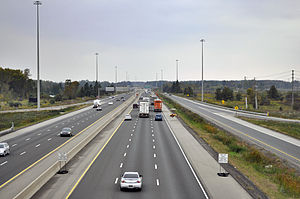 400-Series Highways typically have high design standards. This stretch of Highway 401 in London, Ontario, includes rumble strips, hard left and right shoulders, wide driving lanes, high mast lighting, an Ontario Tall Wall median, overhead signage, acceleration and deceleration lanes and a collector lane.
400-Series Highways typically have high design standards. This stretch of Highway 401 in London, Ontario, includes rumble strips, hard left and right shoulders, wide driving lanes, high mast lighting, an Ontario Tall Wall median, overhead signage, acceleration and deceleration lanes and a collector lane.
Highway standards
Most 400-series highways follow a list of required construction standards similar to those of many other controlled-access highway systems. However, in some cases, different standards applied at the time of construction and have been grandfathered to the system. This is most prominent on Highway 400, Highway 401, and the Queen Elizabeth Way, whose low standard sections are only upgraded when growing traffic conditions warrant a major reconstruction. Although some highways receive a 400-series number right away, they are not built to 400-series standards until construction of the highway is completed.
Roadway
All 400-series highways should have at least two lanes in each direction, with HOV lanes separated from general traffic with a striped buffer zone and full shoulder if necessary. Lanes of opposing directions should always be separated either by a grass median, usually of sufficient width to prevent cross-directional collisions, to provide drainage, and may allow for future expansion, or an "Ontario tall-wall" concrete barrier if a grass median is not feasible (the tall wall is based upon the Jersey barrier but is not reinforced and higher at 1070-mm.[1] Full-width left and right paved shoulders are employed on 400-series highways, with rumble strips on each side of the carriageway.
Most 400-series highways have design speed of at least 130 km/h, although the posted speed on signs is 100 km/h. Exceptions could be made for sections in urban areas where a 130 km/h design speed cannot be realistically implemented, including Highway 403 through Hamilton (90 km/h), Highway 406 through downtown St. Catharines (80 km/h), and near approaches to border crossings (Highway 401 in Windsor, 402 in Sarnia, and 405 in Niagara-on-the-Lake), which all have a maximum speed of 80 km/h.
Unless there are land space constraints, 4-way junctions should employ parclo interchanges with ramps on the right-hand side where they meet with a surface road in order to help maintain speed on the highways. However, there is no standard for freeway-to-freeway junction as it depends upon traffic volumes, only that there must not be any traffic weaving when merging onto each road (this makes interchanges such as the cloverleaf not up to 400-series standard).
Acceleration/deceleration lanes from interchanges must be at least 150 metres long to allow for smooth speed increase/decrease and traffic merging, unless there are land space constraints or low traffic volumes. Such exceptions include the Kipling Avenue to Highway 409 directional ramp and the Dundas Street eastbound to Highway 427 southbound directional ramp. The stretch of the QEW through St. Catharines just west of the Garden City Skyway is well known for lacking acceleration/deceleration lanes, as it was originally built in the 1950s; while it has been grandfathered in with merge signs, a planned reconstruction will bring it up to modern standards. In addition, 400-metre or longer "weave lanes" are required for transitions to/from HOV lanes across the buffer zones to allow for safe mergers.
Signage
All 400-series highways employ standardized signage. The standard directional signage is white-on-green, with collector lanes using white-on-blue to distinguish between mainline (express) and collector signage. Toll roads (i.e. 407 ETR) also need to have white-on-blue signage. Advanced warning signage are placed at 2 km, 1 km and 500 m before junctions, and square lane deviation signs (unique to Ontario) notifying drivers approximately 1 km before their lane leaves the highway. Separated high-occupancy vehicle lanes use black-on-white signage with a diamond logo in the upper left-hand corner.
Most service/attraction signage used on 400-series highways is white-on-blue, though older brown-on-white signs still exist. Caution signage is black-on-yellow, while construction (temporary conditions) signage is black-on-orange.
Roadside advertisements (e.g. billboards) are banned from the right-of-way of 400-series highways. The province has also obtained court orders forcing the removal of advertising signs that are outside of the highway corridor, but adjacent to and still visible from, a 400-series highway (such as along nearby farms close to the freeway). This ban exists to prevent driver distraction. By contrast, the elevated portion of the municipal Gardiner Expressway has many adjacent signs.
Many 400-series highways have also recently had gates installed at entrance ramps, along with special gated ramps located near overpasses, allowing access to the highway to be easily closed in case of emergency or road work.
Some 400-series highways have bilingual English-French signage (400, 401, 404, 409, 416, 417, 427). The QEW had bilingual signs, but they have since been removed.
Safety Features
The 400 series highways incorporate the latest safety features. Guard rail is being replaced with Ontario Tall Wall when needed. The use of box-beam guard rails have been replaced in some stretches with Ontario Tall Wall or standard guardrails.
List of 400-series highways
There are 15 different 400-series highways (including the QEW) creating a transportation backbone across the southern portion of the province. Plans are currently underway to extend the existing network into Northern Ontario as well as add new routes into the system. Total length of the entire 400-series system about 1,500 kilometres.
Designation Photo Alternate names Total length (km) Year inaugurated North/east end South/west end Description Map 400


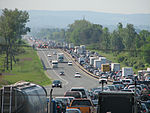
Barrie-Toronto Highway (prior to 1952) 209 1952 Highway 559 North of Nobel (continues as Highway 69) Maple Leaf Drive overpass in Toronto Highway 400 is Toronto's main highway link to York Region, Barrie and Muskoka. It is the second-longest 400-series highway. Highway 400 is expected to be extended to Sudbury by 2017.
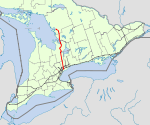
401
 _
_

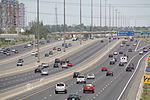
Macdonald-Cartier Freeway; Highway of Heroes (between Don Valley Parkway in Toronto and Trenton)[2][3] Highland Creek-Newcastle section designated as Highway 2A prior to 1952
817.9 1952 Quebec Border (continues as Autoroute 20) Highway 3 in Windsor Highway 401 is the backbone of the 400-Series network taking nearly 30 years to be built and running across the entire length of Southern Ontario. It has volumes of over 500,000 per day in some areas of Toronto, making it one of the busiest highways in the world.[4] 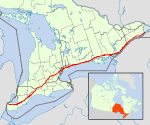
402

Blue Water Bridge Approach (prior to 1952) 102.5 1952 Highway 401 in London Blue Water Bridge in Point Edward (in Sarnia) Highway 402 connects Interstates 69 and 94 in Michigan with the 401 in Ontario. It initially terminated at Highway 40, but was later extended to meet up with Highway 401. 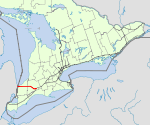
403

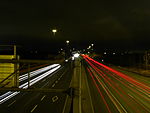
Chedoke Expressway (through Hamilton) 112.4 1963 Highway 401 and Highway 410 in Mississauga Highway 401 in Woodstock Highway 403 forms a loop that runs from the Highway 401 in Woodstock back to the junction of Highway 401 and Highway 410 in Mississauga, passing through Brantford, Hamilton, and Mississauga. The section of the QEW between Burlington and Mississauga is shared with Highway 403. Highway 403 is one of three highways (along with highway 404 and the QEW) with high-occupancy vehicle lanes. 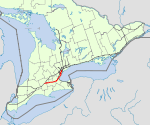
404

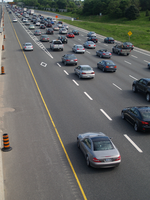
commonly referred to as the extension of the Don Valley Parkway prior to 1977; Now termed Parkway-404 and vice-versa 36.8 1977 Herald Road/Green Lane in East Gwillimbury Highway 401 and Don Valley Parkway in Toronto Highway 404 is the second north-south freeway in York Region and connects the northeastern suburbs and into Toronto as the Don Valley Parkway. It is one of three highways (along with Highway 403 and the QEW) with high-occupancy vehicle lanes and the only one with a dedicated HOV off-ramp, which serves Highway 401 westbound from Highway 404 southbound. 
405

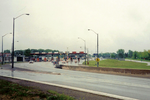
General Brock Parkway (since 2006) 8.5 1963 Lewiston-Queenston Bridge (connects to the United States) Queen Elizabeth Way, west of Niagara Falls Though a short spur route, Highway 405 is still considered a major highway connecting the main trunk highway to Toronto (the QEW) with Interstate 190 outside of Niagara Falls, New York. 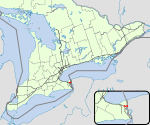
406

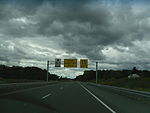
25 1965 Queen Elizabeth Way in St. Catharines East Main Street (Highway 7146) in Welland Highway 406 is the last remaining 400-series highway under Ministry of Transportation jurisdiction with two-lane non-freeway sections, located between Thorold and Welland. Plans to extend the route further south to the proposed Mid-Peninsula Highway have been voiced. 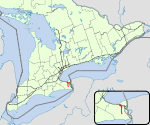
407

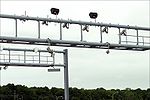
Express Toll Route 108 1997 Highway 7, near Brock Road in Pickering Junction of Highway 403 and the Queen Elizabeth Way in Burlington Highway 407 forms a northern bypass for Highway 401 and the Queen Elizabeth Way through the Greater Toronto Area. It is Ontario's only toll highway and was the first highway to use electronic toll collection exclusively for its entire length. Owned by Cintra, it is not officially considered part of the King's Highway system. 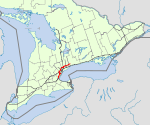
409

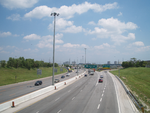
formerly known as the Belfield Expressway 4.4 1975 Highway 401 in Toronto Airport Road in Mississauga Highway 409 is a short connector route from the 401 to Toronto Pearson International Airport. A short section of the route between Airport Road and Highway 427 in Mississauga is under the jurisdiction of the Greater Toronto Airport Authority. 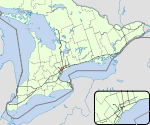
410

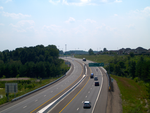
20.3 1979 Hurontario Street / Highway 10 in Brampton Highway 401 in Mississauga Highway 410 runs from the junction of Highway 401 and Highway 403 in Mississauga through Northern Mississauga and Brampton. 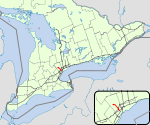
416


Veterans Memorial Highway 75 1996 Highway 417 in Ottawa Highway 401, north of Johnstown and the Ogdensburg–Prescott International Bridge Highway 416, except for its northernmost 21 kilometres, follows the former route of Highway 16. It is the newest 400-Series highway to be built and owned by the Ministry of Transportation and is the main link (via the 401 and I-81) between the US and the National Capital Region. It was officially completed on September 23, 1999. 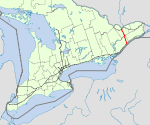
417



Queensway (through most of Ottawa) 182 1971 Quebec border (continues as Autoroute 40) Arnprior (continues as Highway 17) Highway 417 is the main freeway through Ottawa and Eastern Ontario along the Ottawa River and Quebec border. The Ministry of Transportation hopes to eventually extend the 417 through the Ottawa Valley. Its mileage logs, unlike most other east-west highways in Ontario, begins at the eastern terminus rather than the west. 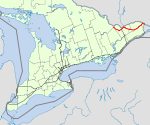
420

commonly referred to as part of the Queen Elizabeth Way prior to 1972 3.8 1972 Stanley Ave in Niagara Falls, where it continues to the Rainbow Bridge as Regional Road 420. Montrose Road in Niagara Falls Highway 420 connects the QEW to the tourist district in Niagara Falls. Portions of it were transferred to the City of Niagara Falls in 2000 and became Regional Road 420. The Ministry of Transportation hopes to extend the 420 west past Montrose Road to meet up with Highway 58 and the Thorold Tunnel. 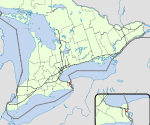
427


known as Airport Expressway (between Highway 401 and Highway 409) prior to 1972 21.3 1972 Highway 7 in Vaughan (Unofficially to Zenway Blvd) Evans Ave in Toronto Highway 427 serves the heavy-travelled area between the Queen Elizabeth Way and Gardiner Expressway in the south and Highway 7 (Unofficially to Zenway Blvd) in the north. It has heavy traffic volumes and occupies no less than 12 lanes between the Queen Elizabeth Way/Gardiner Expressway and Highway 401. 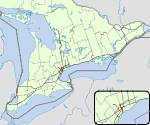
Queen Elizabeth Way (QEW)

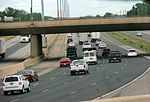
known as Highway 451 or Highway 1 Internally. 139 1939 Peace Bridge in Fort Erie Highway 427 in Toronto, where it continues as the Gardiner Expressway Humber River before the 1998 provincial downloading.
The QEW is North America's oldest long-distance superhighway. It is not referred to by a route number, but does have several internal designations, including Highway 1 and Highway 451, and is considered part of the 400-Series network. It also uses city names rather than cardinal directions to direct (and to not confuse) motorists. The QEW is one of three highways (along with highway 403 and highway 404) with high-occupancy vehicle lanes. 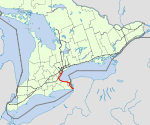
Former 400-series highways
Due to government restructuring in 1997 and 1998, various sections of provincial highway were transferred over to local jurisdictions. While most of the highways transferred were local in nature, several large routes including freeways were transferred to local governments.
Designation Total length (km) Year inaugurated Year decommissioned North/east end South/west end Current status Description 400A 1.1 1960 1997 Highway 11 in Barrie, Ontario Highway 400 in Barrie, Ontario Section of Highway 11 Highway 400A was a short spur connecting Highway 400 to the Highway 11 expressway northeast of Barrie. It was initially part of Highway 400 until 1960, when a new section of Highway 400 opened, bypassing 1.1 km of freeway, which was re-numbered Highway 400A and became the shortest 400-series highway. 401A 3.0 1952 1997 Highway 401 in Windsor, Ontario Highway 3B (Howard Avenue) in Windsor, Ontario Maintained as Dougall Parkway by City of Windsor Highway 401A (also referred to as Highway 3B) was the original alignment of Highway 401, from 1952 until 1964, before it was re-routed to connect directly to Highway 3. It was downloaded to the City of Windsor in 1997 and has since been renovated. Segment of QEW (east of Highway 427) 6 1939 1997 Gardiner Expressway in Toronto, Ontario Highway 427 in Toronto, Ontario Section of the Gardiner Expressway This segment of the QEW was transferred to the City of Toronto in 1997 as a cost savings measure by the Ontario provincial government. It has since been re-designated as a western extension of the Gardiner Expressway. Future additions
There are several plans in progress to add new routes to the 400-series highway system to serve the growing population of motorists throughout Ontario, specifically Southern Ontario. Some of these new routes may be toll roads owned and operated in a similar fashion to Highway 407. In addition, the long-term extension of Highway 417 towards North Bay (and beyond), as well as construction of a staged freeway on the Highway 11 corridor, would likely absorb the existing freeway sections of Highway 11 and Highway 17 into 400-series highways. Also, a highway to connect the City of Guelph to highway 410 and later 400 is in the planning stages.
HOV lanes
The Ontario Ministry of Transportation has announced a major expansion of HOV lanes within the Golden Horseshoe, and the National Capital Region.[5] The first HOV lanes in the Greater Toronto Area (GTA) were introduced to Highway 404 (southbound) from Beaver Creek (between Highway 7 and 16th Avenue) in York Region to Highway 401/Don Valley Parkway in Toronto. An exclusive HOV ramp/tunnel from the Highway 404 HOV lane to the Highway 401 westbound collectors was also built at the same time in Toronto. In addition, HOV lanes were introduced on Highway 403 from Highway 401/Highway 410 to Highway 407 in Mississauga.
In May 2007, the Ministry of Transportation introduced a multi-billion dollar Horseshoe Network Project, which includes plans to incorporate HOV lanes into numerous 400-series highways. On July 23, 2007, an HOV lane was opened on Highway 404 (northbound) from the north of Sheppard Ave to Highway 7, matching the current southbound HOV lane.
More than 450 kilometres of HOV lanes are expected to be implemented in 400-series highways. The general goals of the project is to help increase highway efficiency (an HOV lane is expected to have the ability to move as many people as four general-purpose lanes),[5] reduce congestion, conserve energy and help protect the environment.
Project plan
Highway Starting location Terminating location General location Near-term (2007—2011) QEW Burloak Drive 3rd Line Region of Halton Burloak Drive Guelph Line 3rd Line Trafalgar Road 427 Highway 409 Highway 407 near Pearson International Airport in Toronto 400 Major Mackenzie Drive W. Kirby Road/King Road Region of York Mid-term (2011—2017) 401 Mississauga Road Highway 403 Mississauga 400 Kirby Road/King Road Highway 9 Region of York 404 Highway 7 Aurora Road Long-term (2017—) QEW Red Hill Valley Parkway Highway 406 Hamilton and Region of Niagara 407/403 Guelph Line Burlington Trafalgar Road Highway 427 Oakville and Mississauga 403 Highway 6 Highway 407/Queen Elizabeth Way Hamilton and Burlington QEW Highway 407 Mississauga 400 Highway 9 Highway 88/Barrie Region of York and Simcoe County 401 Milton Mississauga Road Brock Road Ritson Road Region of Durham 404 Aurora Road Keswick Region of York 410 Highway 401 Queen Street Brampton Future 400-series highways
Designation Alternate names Planned inauguration year Planned north/east end Planned south/west end Current status Description Undetermined Mid-Peninsula Highway 2030s Queen Elizabeth Way in Fort Erie, Ontario Highway 407 in Burlington, or Highway 401 near Milton Proposed The Mid-Peninsula Highway will serve as southern bypass of the QEW through the environmentally sensitive Niagara Peninsula. It is a highly controversial project as it will likely run through tender agricultural areas and the Niagara Escarpment, and many question the need of the highway. Undetermined Bradford Bypass 2020s Highway 404 near Queensville Highway 400 near Bradford, or Highway 427 near Bond Head Planning The Bradford Bypass will serve as a connector between Highways 400 and 404 on the northern portion of the Greater Toronto Area. Predominantly a local issue, as the province does not consider the bypass a priority. Undetermined West Durham Link 2015 Highway 407, just east of the proposed Pickering Airport Highway 401 on the Ajax/Whitby border Planned The West Durham Link will serve as a connector between Highway 401 and Highway 407 east of Lakeridge Road. Plans for this new freeway will see it located near Lake Ridge Road between Ajax and Whitby. Undetermined East Durham Link 2020 Highway 407 Highway 401 in Clarington, in the community of Courtice Planned The East Durham Link will serve the east end of Durham Region, including Oshawa and Clarington. The alignment will be located east of Courtice Road in Clarington. See also
- List of Ontario expressways
- List of Ontario provincial highways
- 100-Series Highways of Nova Scotia
- Quebec Autoroutes
References
- ^ Basics of Concrete Barriers
- ^ City News
- ^ CTV.ca
- ^ Ministry of Transportation (Ontario) (6 August 2002). "Ontario government investing $401 million to upgrade Highway 401". Archived from the original on May 07, 2003. http://web.archive.org/web/20030507162458/http://ogov.newswire.ca/ontario/GPOE/2002/08/06/c0057.html?lmatch=&lang=_e.html. Retrieved 2006-12-20.
- ^ a b High Occupancy Vehicle (HOV) Lanes
External links
- Ontario Ministry of Transportation
- Database of Ontario Provincial Highways
- VEHICLES ON CONTROLLED-ACCESS HIGHWAYS, R.R.O. 1990, Reg. 630
- History of Ontario's Highways
- Photographs of Ontario Highways
- Photographs and history on the 400-Series Highways (and other provincial highways, too)
Controlled-access highways of Ontario 400-series highways Other highways Current: 2A · 11 · 58 · 115 · 137 · Conestoga Pkwy. · Dougall Pkwy. · E.C. Row Expwy. · Hanlon Pkwy. · Queensway · Thunder Bay Expwy.
Municipal: Black Creek Dr. · Burlington St. · Cootes Dr. · Don Valley Pkwy. · Gardiner Expwy. · Harbour Expwy. · Highbury Ave. · Lincoln M. Alexander Pkwy. · Queensway · Red Hill Valley Pkwy. · Vets Mem. Pkwy. · W.R. Allen Rd.
Proposed: GTA West Corridor · Halton–Peel Freeway · Mid-Peninsula Highway · Bradford Bypass · West Durham Link · East Durham LinkCounty roads in Ontario · Ontario numbered highways · Expressways and 400-series highways · King's Highways · Secondary highways · Tertiary and 7000-series highways · List of Ontario provincial highways · List of former provincial highways in Ontario · Highways in Ontario · List of Ontario expressways · Trans-Canada Highway · Connecting Link · Emergency Detour RouteCategories:- 400-series highways in Ontario
- Ontario-related lists
- Lists of roads in Ontario
Wikimedia Foundation. 2010.


